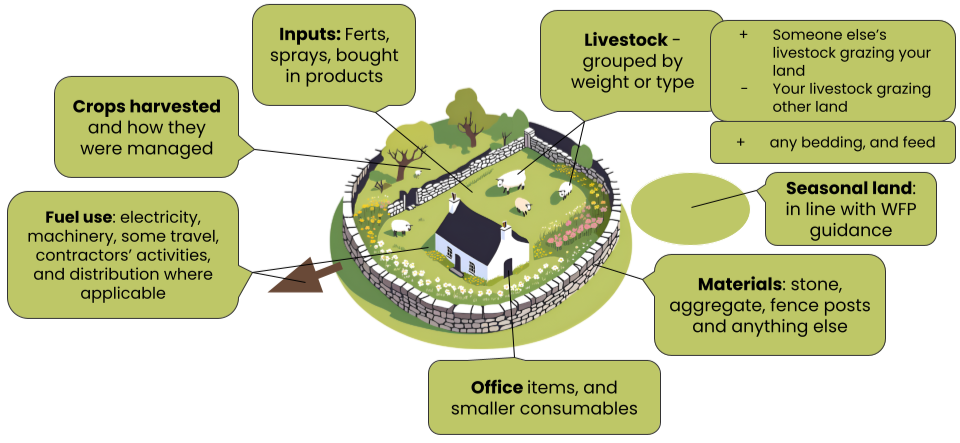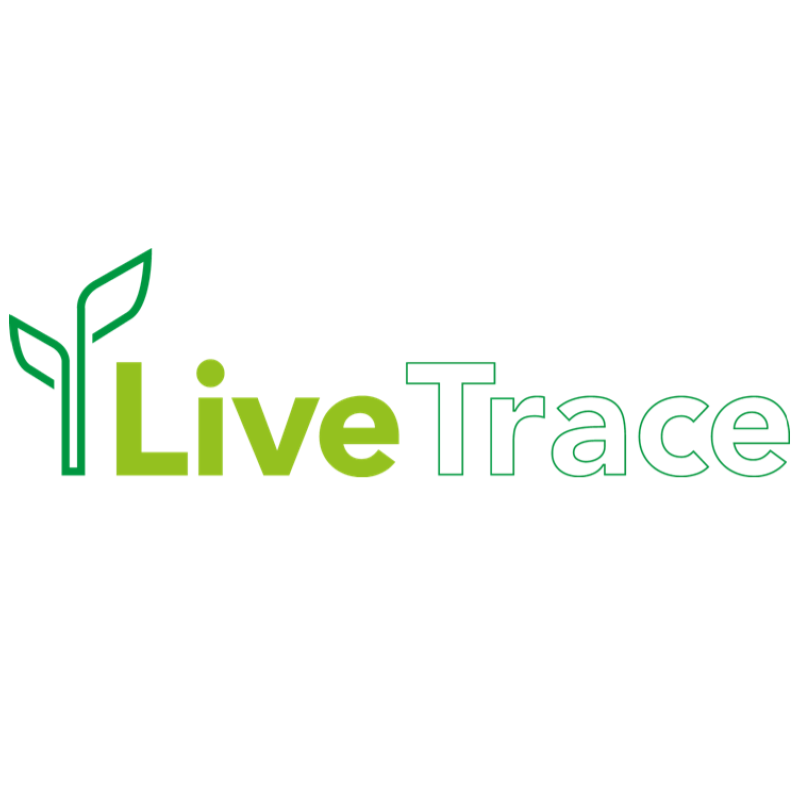
As a leading carbon assessment tool, The Farm Carbon Calculator is updated on a regular basis. We do this so you benefit from the most recent science, can access additional features, and have an improved experience completing reports. Read on to find out more.
Key Takeaways
- Reports ending on or after 01 April 2025 will use the updated emissions factors outlined in What’s Changed 2025
- Some changes have been backdated to improve all reports from 01 January 2000 onwards – these will only be applied if you recalculate a report or edit an item.
- To maintain a record of your original report, LOCK and do not edit old reports
- Instead, make a copy of an old report – this will apply any backdated changes and give you the option to compare to the original report to see what has changed
- If you are making a new report you will have many more options for adding:
- Specific sprays (branded herbicides, fungicides etc.) “Inputs > Sprays” section
- Branded & generic fertilisers “Inputs > Specific fertilisers” section
- Imported organic fertility sources and the emissions from their application “Crops > Organic fertility sources”
- Potential sequestration from Agroforestry areas “Sequestration > Agroforestry” section

Our Development Cycle
Every April we release updates to the methodology behind the Calculator as well as tweaks to the ways reports are made.
This Spring we will update the calculator 3 times;
- Our annual comprehensive methodology and functionality update.
- Improvements to how we calculate livestock emissions.
- Improvements to our calculations of land-use change emissions.
We’ll focus here on the first of these which will launch on 1 April 2025. Our methodology is the combination and range of formulas which sit behind the calculator and help us calculate emissions on any farm in the UK. We have updated the emissions factors in this methodology, we added new ones, and we have acted on your feedback to improve the way the calculator looks and feels to ensure the system continues to work for you.
Emissions Factors – if you were wondering – are the variables used in the formulas behind your report. They tell us, for example, the emissions produced when fuel is burned, and the emissions produced in manufacturing the fuel in the first place.
Our updated methodology is used for the main calculator at https://calculator.farmcarbontoolkit.org.uk, and also by many users of external applications. For example, many farm management systems, banks, and consultants rely on our methodology, as well as multiple white labelled or more specialised calculators across the agricultural industry, and beyond – like the Equine Carbon Calculator.
We’re talking here about thousands of farms creating multiple thousands of reports every year – our team spends the bulk of their time ensuring everything fundamental is right!
We know changes to methodology affect carbon reports, and carbon reports reflect your farm – so you deserve to know a bit about how this is changing. Let’s ask the obvious question first:
Why does the methodology keep changing?
In short, because the underlying sources have changed or updated. The calculator sits on top of thousands of hours of research and experience, coming from within our team over 16 years of development, from agronomists and farmers, from academia, and the research arms of governments and international organisations. The result of this work is the wide range of sources you can see on our references page.
Emissions factors change
Every spring, all emissions factors are checked, and in some cases are changed – for our April 2025 methodology that is 3,000 existing factors, and 7,000 new ones! We update some factors to match new versions of existing data sources, such as annual governmental data sets like the UK GHG inventory which details UK industrial emissions. Our factors and data sources also change as new items are added, better sources become available, and in some cases, factors change because sources fall out of use as they become outdated or irrelevant. Overall the methodology relies on 114 references which can be found on our references page, or listed with each item in our data collection sheet, which can be downloaded from our resources page.
Changes to emissions factors also occur because more industries are undertaking more rigorous carbon footprinting so we can get a better estimate of the emissions from producing, transporting and using various products. This work provides us more granular detail on emissions and allows us to give you more options when selecting items in your reports.
Moreover, as sectors decarbonise, the emissions associated with utilities and commodities change, and thus we need to update emissions factors to reflect this. As an example, this year the emissions associated with the average tariff for electricity have reduced by nearly 10%, due to an increase in the proportion of electricity coming from renewable energy. We therefore want you to see the benefit in your reports as industries decarbonise, so your electricity use this year will be lower than the year before even if the same quantity of energy is used. This should not deter you from making your own efforts to decarbonise, but does allow you to share the benefits of UK progression.
Emissions calculations undergo review
Sometimes the calculations underlying your report change because of an improved understanding of biological systems or a re-interpretation of the available evidence. In a developing field like agricultural carbon footprinting, working with other organisations to make sense of the available evidence and international guidance within the UK context can help us identify areas where calculations can be improved. This is why we continue to seek pre-competitive collaborations with other companies and research organisations (to find out more about the projects and harmonisation work).
One such calculation that has undergone re-interpretation is the calculation underpinning organic fertility emissions. With a better understanding of the underlying processes, and the components relevant to the equation, we have been able to add more specificity and more options to the organic fertility options. You will now see options for when and where fertility sources are applied, and for manures you will have the ability to select application approaches – meaning emissions mitigation approaches such as deep-injection of slurry are appropriately adjusted. Changes like these allow you to better understand your carbon footprinting journey and allow a more nuanced appraisal of your farming emissions. We are striving to increase the specificity of the calculator, aiming to provide you the user with the opportunity to enter the highest tier of emissions calculation.
There are 3 tiers of GHG emissions calculations
Tier 1: This tier uses default emissions factors and data from the IPCC for different climatic regions to generate broad estimates. The use of global data and a general approach results in low accuracy.
Tier 2: This method enhances accuracy by using emission factors specific to a country or region and more detailed activity data, such as local energy consumption. This approach is more accurate than Tier 1 because it incorporates factors that are more relevant to the specific conditions of the region.
Tier 3: Uses real-time data, sophisticated models, and system-specific emission factors, and is the most accurate method, using detailed modelling or direct measurements, as well as highly specific data for the particular circumstances of the country or sector.
We are striving for tier 3 where practical in your reports, however, the reality is that most people do not have time to enter the copious data required for accurate calculation at tier 3.
Changes to the calculator
As explored above, an update like this one has introduced many changes, you will see these highlighted in full:
- In our ‘What’s Changed’ document
- In our published corrections
- In our methodology
One example of an item on the calculator that has recently changed is sugar beet crop residues. In 2024, we updated and improved our methodology that accounts for the N2O emissions associated with crop residues decomposing in the field after harvest. This used crop N contents and harvest index ratios from the UK GHG Inventory (1990- 2021 Inv) plugged into the IPCC 2019 refinement crop residue calculation, making it a Tier 2 method. This calculation gave sugar beet a relatively high emissions factor compared to other crops.
This year the UK GHG inventory released a new version (1990 – 2022), which has updated their values for sugar beet. This update by the UK GHG inventory includes adjusting the harvest index, lowering N contents for aboveground and belowground residue and lowering above to below-ground residue ratios; all of which are used for “deriving a country-specific parameter for sugar beet residue emissions”. This has resulted in a 77 – 89% decrease in the April 2025 update depending on the residue management practice. As this is such a large change, which has been updated with better data, we have decided to backdate this emissions factor to ensure drastic changes between years for the same amount of crop residue are not reported.
Not all changes in the calculator are this drastic, and in the “What’s Changed” document you will see a list of changing emissions factors.
So will my carbon footprint go up or down?
We can’t predict with certainty how annual updates will affect your report because every farm is different, but we know there will be changes. It very much depends on what you do on the farm and the best way to see this will be to copy a report, change the end date and see for yourself. We will see some examples of farm reports below. Changes to how you farm will, in most cases, have a larger and more important monitorable effect than changes to the methodology we talk about here.
In other words – if it is your focus, keep looking for ways to reduce emissions on your farm! Bear in mind that changes to practice can take time to show up in your carbon footprint and may have other impacts, be it environmental (benefitting biodiversity, reducing water use, cleaning soil and air pollution), social (ensuring food security, providing jobs, leaving space to roam, nurturing communities) or financial (boosting profits, building resilience, or ensuring financial security). These impacts may not result in reduced carbon emissions, however at FCT we fully support farmers taking a holistic all-encompassing approach to improving their sustainability. If you would like support or advice on reducing your farm’s footprint as part of the wider context of your farm, our advisors can help.
The rest of this blog will dig into some examples of what might change for some example reports.
Visualising the changes with example reports
We have created example farm reports that compare emissions factors before and after the April update for various farming systems. These reports, which span April 2023 to March 2024 and April 2024 to March 2025, use consistent items and quantities to ensure the thing changing is the emissions factors. It’s crucial to remember that actual farm reports will vary year-to-year due to changes in both practices and purchased materials, not just emissions factors.
As you can see in Figure 1, comparing the same reports across both periods does not result in large differences. Table 1 gives the percentage change in the total carbon emissions (tCO2e) and total carbon balance (which includes carbon removals by sequestration – tCO2e) for each report. On average, reports with the updated emissions factors resulted in a decrease in total carbon emissions and total carbon balance. This will vary depending on what items have been chosen in reports.

The dairy report experienced an increase due to livestock feeds being updated with the latest Global Feed LCA Institute source (GFLI). In comparison, the poultry and the beef report experienced a decrease in emissions due to updating this same source, as some feed items have increased, whilst others have decreased.
The large decrease in the carbon balance for the poultry report is due to a combination of emissions factors decreasing e.g. livestock feeds and bedding (-21.58%), materials (-8.86%) and fuels (-5.43%) alongside changes in carbon sequestration factors (-8.75% i.e. an increase in sequestration), resulting in a relatively large decrease in the carbon balance.
The arable and horticulture report have remained relatively similar with changes below 5%. To see a more detailed breakdown of what changed in these reports and in the calculator, check out our What’s Changed document.
| Report | % Change in Emissions | % Change in Balance |
|---|---|---|
| Arable | 0.87 | 1.11 |
| Beef | -10.48 | -11.65 |
| Dairy | 3.78 | 5.43 |
| Horticulture | 3.54 | 3.91 |
| Poultry | -9.16 | -54.30 |
| Average | -2.29 | -11.10 |
It’s not just changes – there are new items too!
Importantly, we also use this update to add in new items that people have requested. In this update you can expect to see:
- Over 6000 more specific sprays (branded herbicides, fungicides etc.)
- Over 100 more branded & generic fertilisers
- The ability to search an item in the inputs section to quickly find your item on our system
- Over 400 new imported organic fertility sources and the emissions from their application in different seasons and with different application methods
- New options for agroforestry and silvopasture including a range of densities and ages of woodland
- New options to enter market garden crops on a smaller scale
- New options to enter landscaping materials associated with paving and decking
For a full list of what has been added see the “What’s Changed” document, or the data collection sheets, where new Items have been flagged with a star.
Communicating this change
If you need to communicate this article in a sentence, for example alongside your report within a supply chain, or to accompany a project you are involved in, use this:
The Farm Carbon Calculator has updated its emissions factors in line with the latest data sources – detailed information about what has changed can be found at https://calculator.farmcarbontoolkit.org.uk/resources
Further support
Contact Michael Brown at [email protected]




























Recent Comments